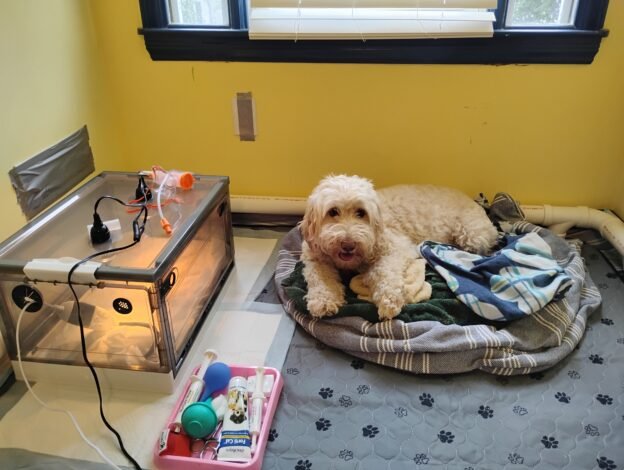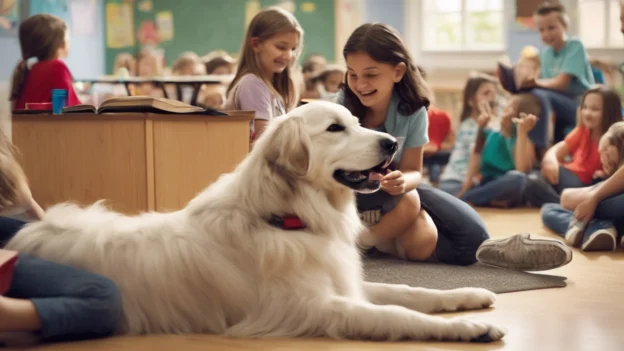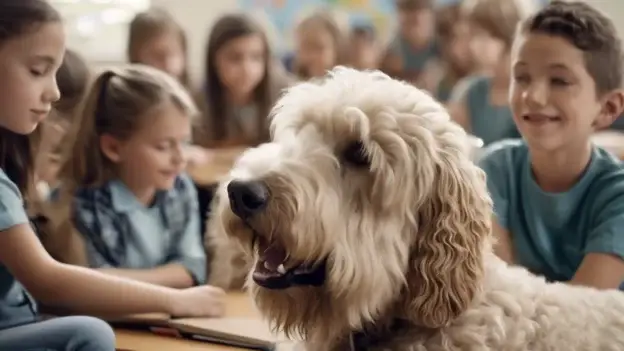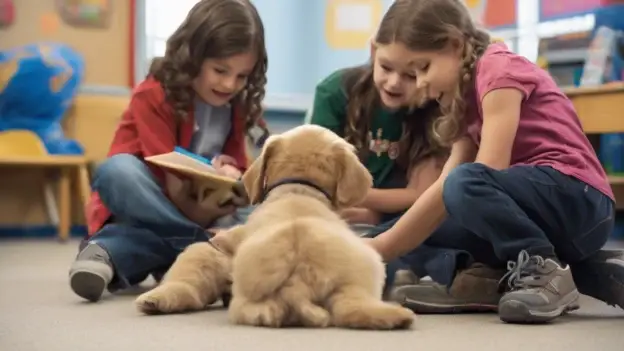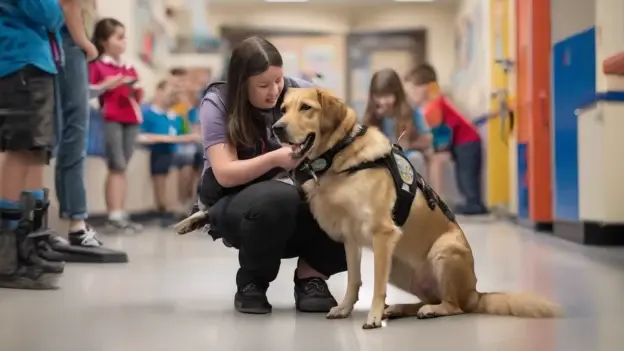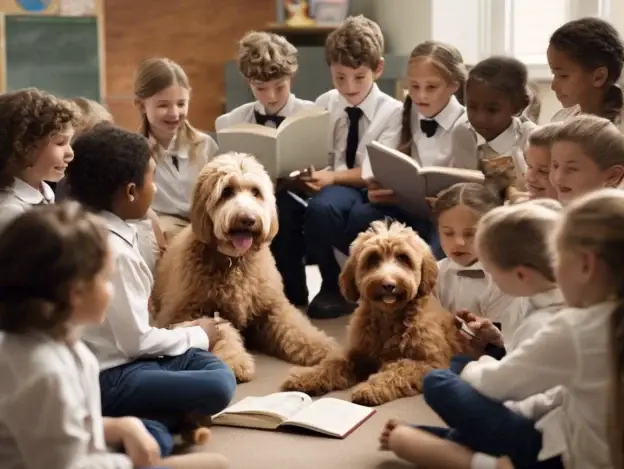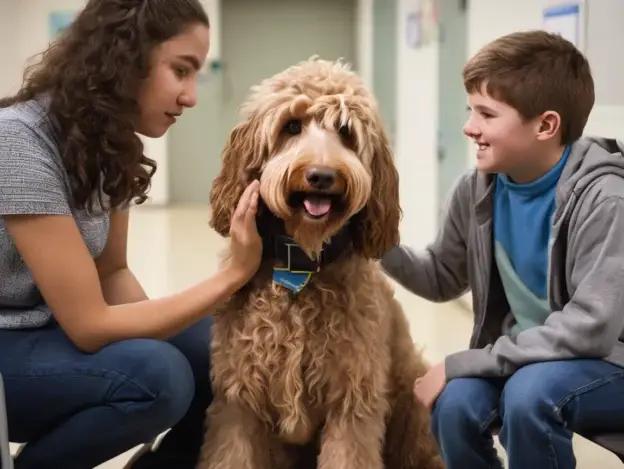When introducing dogs into educational environments, it’s crucial to understand the distinct categories of working dogs and their specific legal rights, training requirements, and appropriate roles. At School Dogs LLC, we frequently help educational institutions navigate these important distinctions to create effective and compliant programs. This comprehensive guide will clarify the differences between service dogs, therapy dogs, and emotional support animals in school settings.
Legal Definitions and Access Rights
The distinctions between these categories are defined by federal law and come with significantly different access rights and protections.
Service Dogs
Legal Definition:
The Americans with Disabilities Act (ADA) defines service animals as “dogs that are individually trained to do work or perform tasks for people with disabilities.” These tasks must directly relate to the person’s disability.
Legal Access Rights in Schools:
- Protected by federal law (ADA)
- Must be allowed in all areas where students typically go
- Cannot be denied access to classrooms, cafeterias, or school events
- No special certification is legally required (though training standards exist)
- Schools can only ask two questions:
- Is this a service animal required because of a disability?
- What work or task has the dog been trained to perform?
Examples of Service Dogs in Schools:
- Guide dogs for visually impaired students
- Hearing alert dogs for deaf students
- Mobility assistance dogs
- Seizure response dogs
- Diabetic alert dogs
- Psychiatric service dogs trained for specific tasks (not emotional support)
Important Note:
Service dogs are working medical devices under the law and are not present as pets. They have specific trained tasks that mitigate their handler’s disability and should not be petted, distracted, or interacted with by others without permission.
Therapy Dogs
Legal Definition:
Therapy dogs have no formal federal legal definition but are generally understood to be dogs trained to provide comfort and support in various settings through their calm temperament and reliable behavior. They work with a handler (not the person receiving support).
Legal Access Rights in Schools:
- No federal protection for access rights
- Entry permitted only by invitation and agreement of the facility
- Must comply with all school policies and procedures
- Required to have liability insurance (typically through therapy dog organizations)
- May be required to show proof of training, certification, health records, and vaccination status
Examples of Therapy Dogs in Schools:
- Reading assistance dogs for literacy programs
- Stress reduction dogs during testing periods
- Support during counseling sessions
- School-wide wellbeing programs
- Specific classroom-based interventions
Important Note:
Unlike service dogs, therapy dogs do not have public access rights. Their presence in schools is at the institution’s discretion and should be formalized through proper policies and procedures.
Emotional Support Animals (ESAs)
Legal Definition:
ESAs provide comfort through their presence but are not trained to perform specific tasks related to a disability. They are prescribed by a licensed mental health professional for a person with a diagnosed mental health condition.
Legal Access Rights in Schools:
- No automatic right of access to schools under federal law
- Not covered by the ADA for public access
- May be permitted as a reasonable accommodation under certain circumstances
- Individual agreements must be established with the school
- Requirements vary widely between districts and states
Examples of ESAs in School Settings:
- Individually prescribed support for students with anxiety disorders
- Support for students with depression where the animal’s presence provides therapeutic benefit
- Part of an IEP or 504 plan for a student with emotional/behavioral disabilities
Important Note:
ESAs do not require specialized training for specific tasks (unlike service dogs) and are not afforded public access rights under the ADA. Their presence in schools typically requires documentation from a healthcare provider and specific approval from the school administration.
Training Requirements and Certification
The training standards for each category vary dramatically, which directly impacts their reliability and appropriateness for school environments.
Service Dog Training
Training Standards:
- Typically 1-2 years of intensive training
- 120-600+ hours of task-specific training
- Public access training in various environments
- Training for specific disability-mitigating tasks
- Proofing for reliability under distraction
Certification:
While no legally required certification exists under the ADA, reputable service dog organizations typically implement:
- Public access tests
- Task-specific performance evaluations
- Regular reevaluation of skills
- Health and temperament screening
Handler Training:
The disabled handler receives extensive training on:
- Dog handling skills
- Task maintenance
- Public access management
- Care and welfare of the service dog
- How to advocate appropriately
Cost Investment:
Professional service dog training typically costs $15,000-$40,000 per dog due to the extensive training required.
Therapy Dog Training
Training Standards:
- Comprehensive basic obedience training
- Specialized therapy work preparation
- Exposure to various environments
- Specific training for the intended therapy role
- Testing for appropriate temperament and behavior
Certification:
While not legally required, most facilities require certification through recognized organizations such as:
- Pet Partners (formerly Delta Society)
- Therapy Dogs International
- Alliance of Therapy Dogs
These organizations typically require:
- Observed evaluation of the dog’s behavior
- Handler knowledge assessment
- Liability insurance coverage
- Regular renewal of certification
- Health verification
Handler Training:
The handler (not the recipient of services) must be trained in:
- Reading their dog’s stress signals
- Appropriate integration into therapeutic settings
- Boundary setting for the therapy dog
- Infection control protocols
- Appropriate interactions for various populations
Cost Investment:
Professional therapy dog training typically costs $2,000-$8,000, plus ongoing certification fees and continued education.
Emotional Support Animal Preparation
Training Standards:
- No specific training legally required
- Basic obedience highly recommended but not mandatory
- Appropriate behavior for specific settings advised
- No task-specific training required
- No public access training required
Certification:
No legitimate certification exists for ESAs. Required documentation includes:
- Letter from a licensed mental health professional
- Verification of a diagnosed condition
- Statement of the therapeutic benefit provided
- Regular renewal of documentation may be required
Handler Responsibilities:
The handler should ensure:
- Basic management of the animal
- Appropriate behavior in settings where permitted
- Proper care and welfare
- Minimizing impact on others
Cost Investment:
Costs typically involve regular pet training expenses and potential fees for proper documentation from mental health professionals.
Specific Roles in Educational Settings
Each type of working dog serves a distinctly different function within a school environment.
Service Dogs in Schools
Primary Function:
To enable a student or staff member with a disability to access education by performing specific trained tasks that mitigate their disability.
Appropriate Roles:
- Alerting to medical conditions (seizures, blood sugar changes)
- Retrieving items for students with mobility impairments
- Guiding visually impaired students through school environments
- Providing stability for students with balance issues
- Performing specific psychiatric tasks for students with PTSD, autism, etc.
Working Model:
- One-to-one relationship with the disabled handler
- Present throughout the school day as needed
- Works exclusively with their handler
- Not available for interaction with other students
- Handler directs all of the dog’s activities
Integration Considerations:
- Education of staff and students about appropriate interactions
- Development of emergency procedures that include the service dog
- Notification to other families (without identifying the student)
- Accommodation of allergies or phobias in others
- Handler (or in some cases, a facilitator) maintains responsibility for the dog
Therapy Dogs in Schools
Primary Function:
To provide comfort, support, and therapeutic benefit to multiple students through planned interventions with a trained handler.
Appropriate Roles:
- Reading support programs where students read to the dog
- Presence during counseling sessions to reduce anxiety
- Stress reduction during testing or high-anxiety periods
- Motivation for specific therapeutic goals
- Teaching empathy, responsible interaction, and care
- Supporting trauma-informed educational approaches
Working Model:
- Handled by a trained owner/handler (teacher, counselor, volunteer)
- Present only during scheduled sessions or programs
- Works with multiple students
- Controlled interactions based on program goals
- Handler always present to facilitate appropriate interaction
Integration Considerations:
- Formal policies and procedures for the therapy dog program
- Scheduled visits that don’t overwork the dog
- Appropriate rest areas and breaks
- Parental permission for participation
- Careful monitoring of student-dog interactions
- Clear communication about the program’s goals and boundaries
Emotional Support Animals in Schools
Primary Function:
To provide comfort and emotional support through their presence to a specific individual with a diagnosed mental health condition.
Appropriate Roles:
- Supporting a specific student with anxiety, depression, or PTSD
- Part of an individualized education plan or 504 accommodation
- Providing comfort during specific triggering situations
- Helping a student regulate emotions when overwhelmed
Working Model:
- One-to-one relationship with the individual who needs support
- Presence determined by accommodation agreements
- Not trained for specific tasks but provides comfort through presence
- Typically has limited interaction with others
- Student maintains responsibility for the animal’s care and control
Integration Considerations:
- Documentation requirements clearly established
- Boundaries for the animal’s presence defined
- Impact on other students assessed and addressed
- Emergency procedures developed
- Regular review of effectiveness and continued need
School Implementation Best Practices
At School Dogs LLC, we help schools develop appropriate programs for each type of working dog. Here are our recommendations:
For Service Dogs
Policy Development:
- Create clear service animal policies aligned with ADA requirements
- Establish procedures that protect the handler’s rights
- Develop communication protocols that respect privacy
- Create accommodations for others with allergies or phobias
- Train staff on appropriate interactions and legal requirements
Educational Community Preparation:
- Provide age-appropriate education about service dogs
- Teach students how to behave around working service dogs
- Inform parents about the presence of service animals
- Train staff on emergency procedures including the service dog
- Address questions and concerns proactively
Supporting Success:
- Designate relief areas for the service dog
- Provide water access as needed
- Create a space for the dog to rest when not actively working
- Include the service dog in emergency planning
- Regular check-ins with the handler regarding any concerns
For Therapy Dogs
Program Development:
- Establish clear program goals and objectives
- Create comprehensive policies and procedures
- Develop screening criteria for participating dogs and handlers
- Implement documentation requirements for health and behavior
- Design specific interventions aligned with educational goals
Handler Requirements:
- Verification of appropriate training and certification
- Proof of liability insurance
- Demonstration of dog handling skills
- Knowledge of canine body language and stress signals
- Understanding of educational/therapeutic objectives
Program Management:
- Regular evaluation of program effectiveness
- Documentation of sessions and outcomes
- Schedule management to prevent dog fatigue
- Clear communication with all stakeholders
- Ongoing training for handlers and staff
For Emotional Support Animals
Accommodation Process:
- Establish clear documentation requirements
- Develop a review process for ESA requests
- Create individualized plans for implementation
- Define boundaries and limitations
- Regular reassessment of the arrangement
Balancing Needs:
- Addressing concerns of other students and staff
- Managing potential allergies or fears
- Establishing behavior standards for the ESA
- Creating appropriate care protocols during the school day
- Determining appropriate times and places for the ESA’s presence
Case Studies: Success Stories from School Dogs LLC
Service Dog Success: Alex and Luna
Alex, a high school student with Type 1 diabetes, relies on Luna, his diabetic alert service dog. Luna is trained to detect dangerous blood sugar fluctuations before Alex’s continuous glucose monitor alerts, giving critical early warnings during school activities.
Implementation Approach:
- School-wide education about Luna’s role
- Staff training on emergency protocols
- Designated quiet testing locations for when Luna alerts
- Adjustments to lab safety protocols to accommodate Luna’s presence
- Regular communication between school nurse, parents, and teachers
Outcome: Alex experienced fewer emergency situations, gained independence in managing his condition, and saw improved academic performance due to more stable blood sugar levels. The school community gained valuable education about invisible disabilities.
Therapy Dog Success: Reading with Ruby
Ruby, an Australian Labradoodle therapy dog, visits Winston Elementary twice weekly to support struggling readers in grades 2-4. Students who show reading anxiety or resistance read aloud to Ruby in 15-minute sessions.
Implementation Approach:
- Formal therapy dog program with clear objectives
- Parental permission for participation
- Structured reading sessions in the library
- Data collection on reading progress
- Regular breaks for Ruby to prevent fatigue
Outcome: Participating students showed a 40% increase in reading engagement, improved fluency scores, and reduced anxiety about reading aloud in class. Ruby’s handler reported the dog remained enthusiastic about visits due to careful scheduling and break management.
Emotional Support Success: Emma and Bentley
Emma, a middle school student with severe anxiety and selective mutism, received accommodation for her emotional support dog, Bentley, after documentation from her psychiatrist and therapist.
Implementation Approach:
- Limited schedule accommodation (mornings when anxiety is highest)
- Designated quiet space for Emma and Bentley when needed
- Clear behavioral expectations for Bentley
- Communication plan with teachers and staff
- Regular review of effectiveness and adjustment as needed
Outcome: Emma’s school attendance improved significantly, and she began participating verbally in morning classes. The accommodation was eventually modified as Emma developed additional coping strategies, with Bentley attending only during high-stress periods.
Navigating Common Challenges
Addressing Legal Confusion
Challenge: Schools often misunderstand the legal distinctions between working dog categories.
Solution:
- Provide clear written policies distinguishing each type
- Consult with educational legal experts when developing policies
- Train administration on proper documentation requirements
- Create decision trees for handling various working dog requests
- Regularly update policies as interpretations of laws evolve
Managing Multiple Working Dogs
Challenge: Schools sometimes need to accommodate multiple types of working dogs simultaneously.
Solution:
- Develop protocols for when different dogs might interact
- Create schedules to prevent overwhelming shared spaces
- Consider separate relief areas when possible
- Train handlers on appropriate distancing and interactions
- Clear communication between all programs and handlers
Addressing Community Concerns
Challenge: Parents or staff may have questions or concerns about dogs in schools.
Solution:
- Transparent communication about program goals and safety measures
- Educational materials explaining the different types of working dogs
- Clear processes for addressing allergies or fears
- Regular updates on program outcomes and benefits
- Open forums for questions and clarification
Conclusion
Understanding the distinct categories of working dogs in schools is essential for creating effective, legally-compliant programs that benefit students while respecting the rights and needs of the entire educational community.
At School Dogs LLC, we specialize in helping schools navigate these complexities to implement appropriate programs that match the right type of working dog with specific educational needs. Whether supporting a student with a service dog, implementing a therapy dog program, or accommodating an emotional support animal, clear policies, proper training, and ongoing evaluation are key to success.
By understanding these distinctions and implementing appropriate protocols, schools can harness the tremendous benefits that working dogs can bring to educational environments while ensuring a safe, inclusive experience for all students and staff.


